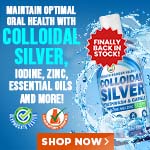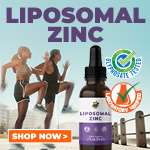
Osteoporosis remains undiagnosed in millions of Americans; here's how to beat the disease with nutrition, exercise and sunlight
 Saturday, July 31, 2004 Saturday, July 31, 2004by Mike Adams, the Health Ranger Editor of NaturalNews.com (See all articles...) Tags: osteoporosis, disease prevention, nutrition |
- Biblical truth: God will carry out a “cosmic reset” of Earth and destroy all human civilization with a series of extinction-level cosmic impacts known as The Seven Trumpets, Seven Bowls and Seven Seals
- Scientists debate possibility of TIME TRAVEL, after Trump Admin says new technologies can "bend space and time"
- U.S. closes controversial State Department office accused of pushing political censorship under Biden
- Russia escalates censorship war, targets over 200 VPN apps amid Google resistance
- Aerosolized bioweapons? Strange “diploid biomasses” falling out of the sky in Florida captured under the microscope
- Eat your MEAT! Study finds children need to eat more animal protein for survival and development
- Trump administration halts major offshore wind project amid fears of “rushed” approvals and environmental compromises
- U.S. demands U.K. protect FREE SPEECH, repeal hate speech authoritarianism, in latest trade deal negotiations
- STUDY: Half of vegans at risk of muscle loss due to nutrient deficiencies
- New York proposes blockchain integration in public payments
- Analysis: The coming economic collapse, a mass uprising and Trump's three secret weapons to halt the growing revolt
- “Wartime Homefront Essential Skills” on BrightU: Experts discuss foraging and 12 medicinal herbs to grow in your backyard
- Unlocking the role of amino acids in Autism Spectrum Disorder (ASD): A review of the evidence
- Kiss Your Genetic Privacy Good-Bye! 23andMe Gets Green Light to Sell Your Intimate Genetic Details to Anyone They Want
- Possible biosignatures detected on Exoplanet K2-18b, raising hopes for alien life
- Trump signs memorandum that seeks to prevent illegals from improperly accessing benefits
- Widespread social and economic unrest: Steve Quayle issues urgent financial warning of imminent asset collapse in new interview with Mike Adams
- Declining imports signal shift in China’s energy strategy
- Aerosolized bioweapons? Strange “diploid biomasses” falling out of the sky in Florida captured under the microscope
- Analysis: The coming economic collapse, a mass uprising and Trump's three secret weapons to halt the growing revolt
- Widespread social and economic unrest: Steve Quayle issues urgent financial warning of imminent asset collapse in new interview with Mike Adams
- Israeli lobbyists boast of controlling US national security policy in leaked AIPAC audio
- Kiss Your Genetic Privacy Good-Bye! 23andMe Gets Green Light to Sell Your Intimate Genetic Details to Anyone They Want
- TAKE IT DOWN Act advances in Congress amid free speech concerns
- Mike Adams releases country western hit single: Goin’ Back in Time is Comin’ Home
- Russia escalates censorship war, targets over 200 VPN apps amid Google resistance
- U.S. lawmakers investigate Meta over alleged China collaboration
- CLOT SHOT PLANDEMIC UNFOLDING: Fibrous, rubbery clots caused by covid injections have prion-like seeding activity
- Warp Speed 2.0: Trump Administration ACCELERATES Gates-funded, self-amplifying bird flu vaccines
- Defunding DEADLY mRNA jabs: Government funding for mRNA technology being scrutinized and sidelined until proven "safe and effective" for real
- Curcumin’s ancient healing power supercharges muscle recovery, and its effects are compounded with anti-inflammatory foods and supplements
- I Want My Bailout Money – new song and music video released by Mike Adams
- Fauci is back in the limelight, and he’s busy promoting a future COVID or FLU pandemic
- I Want My Bailout Money – new song released by Mike Adams
- Trump administration poised to overhaul crypto regulations with new SEC leadership
- Federal employees whine over DOGE's new directive requiring them to do a 5-point summary of weekly accomplishments
- Newly released JFK files reveal Pentagon's role in creating Lyme disease and covid in the same lab
- Analysis: The coming economic collapse, a mass uprising and Trump's three secret weapons to halt the growing revolt
- Aerosolized bioweapons? Strange “diploid biomasses” falling out of the sky in Florida captured under the microscope
- Kiss Your Genetic Privacy Good-Bye! 23andMe Gets Green Light to Sell Your Intimate Genetic Details to Anyone They Want
- Mike Adams releases country western hit single: Goin’ Back in Time is Comin’ Home
- European Court of Justice: Healthcare professionals who promoted or administered COVID-19 vaccines are CRIMINALLY LIABLE for any harm caused
- Widespread social and economic unrest: Steve Quayle issues urgent financial warning of imminent asset collapse in new interview with Mike Adams
- Federal employees whine over DOGE's new directive requiring them to do a 5-point summary of weekly accomplishments
- CLOT SHOT PLANDEMIC UNFOLDING: Fibrous, rubbery clots caused by covid injections have prion-like seeding activity
- U.S. approves new Russian ambassador as diplomatic thaw continues
- I Want My Bailout Money – new song and music video released by Mike Adams
- I Want My Bailout Money – new song released by Mike Adams
- Government waste exposed: Hegseth supports Musk’s demand for accountability from federal workers
- Trump administration poised to overhaul crypto regulations with new SEC leadership
- Defunding DEADLY mRNA jabs: Government funding for mRNA technology being scrutinized and sidelined until proven "safe and effective" for real
- Fauci is back in the limelight, and he’s busy promoting a future COVID or FLU pandemic
- South Carolina Congressman proposes new $250 bill and wants Trump on the front
- Now you can HEAR chemistry: Health Ranger translates molecules into music in stunning video demonstration that will blow your mind (and your ears)
- Red Cross issues warning to stop blood plasma donations from vaccinated people
- Scientists confirm: GENIUS brain function can be spontaneously unleashed in humans without any apparent cause
- EPA advisor admits the agency is funneling billions to climate groups ahead of Trump’s return to White House
- HYSSOP: What research reveals about the health benefits of this ancient holy herb
- Two containers with completed ballots fall out of truck in Florida
- Mike Adams releases country western hit single: Goin’ Back in Time is Comin’ Home
- Newly released JFK files reveal Pentagon's role in creating Lyme disease and covid in the same lab
- Global leaders unite to clamp down on “misinformation” with UN-backed Cascais Declaration
- BREAKING: 2025 NDAA authorizes mandatory military draft of WOMEN across America… as Pentagon pursues global NUCLEAR war with both Russia and China at the same time
- I Want My Bailout Money – new song released by Mike Adams
- Michael Yon warns of a ZIONIST TAKEOVER in Trump’s second administration
- The Health Ranger releases “Vaccine Zombie” song and music video, using AI-animated zombies for the music video
- Ozempic and Wegovy weight loss drugs are injectable LIZARD VENOM PEPTIDES that may unleash a devastating wave of organ failure… side effects align with symptoms of SNAKE BITES
- BOMBSHELL: DNA testing kits are a SCAM to develop ethnic-specific bioweapons
- Israeli soldiers accused of even more torture and abuse in the West Bank
- These 13 countries just signed an agreement to engineer a global FAMINE by destroying food supply
- RFK Jr. clears key hurdle: Sen. Susan Collins backs controversial HHS nominee, signaling a new era for health policy
- NASA admits that climate change occurs because of changes in Earth’s solar orbit, and NOT because of SUVs and fossil fuels
There's a great deal of misinformation about osteoporosis in organized medicine. It's a highly lucrative disease -- more than 17 billion dollars were spent treating osteoporosis in 2001 alone, and I'm sure that number is much higher today. Osteoporosis sounds like a complex disease, but it really isn't. In Western medicine, doctors and researchers like to make things sound far more complicated than they really are, which is why this disease has such a complex-sounding name. But osteoporosis should really be named "brittle bones disease." It's nothing more than brittle bones, or a loss of bone mass or bone density. There's really nothing complicated about it.
The primary sources of this loss of bone mass are quiet simple -- they are diet and physical exercise. And it's not what you necessarily think about diet and physical exercise, so let's take a look at this in detail, and I'm confident you will learn some new information here about osteoporosis.
Osteoporosis is really caused by only three things. They are: 1) diet, 2) physical exercise, and 3) lack of exposure to natural sunlight. It's really not that complex, so let's take a closer look at these three things, and explore their correlation with osteoporosis and loss of bone density.
First, we have diet. When it comes to diet and osteoporosis, most people think that a lack of calcium is the number one dietary concern. But this isn't true -- calcium is only a minor factor when it comes to preventing and treating osteoporosis. Certainly calcium supplements can help, especially if they provide calcium derived from plant sources, but they alone cannot reverse osteoporosis.
The primary dietary cause of osteoporosis is the consumption of highly acidic foods and food ingredients, such as refined white sugar, refined white flour, high-fructose corn syrup, soft drinks, cookies, candies, sweets, desserts, and anything containing sweeteners. Something rather destructive happens in your body when you consume acidic ingredients. Your blood must maintain a specific pH level in order to support human health. If your pH varies from a level of about 7.1, you start to suffer rather destructive side effects, and if it strays extremely far from 7.1, you will die within a matter of minutes. So the body does everything possible to make sure that your blood maintains a healthy pH level. When you consume highly acidic foods, your body has to come up with a strategy for buffering the acidity of those foods with alkaline minerals, and the way it does that is by reaching into your skeletal system to find those alkaline minerals such as calcium and magnesium, then releasing those into your bloodstream to buffer the acidity of the food ingredients you have absorbed. In this way, your body can balance the pH of its blood and keep you alive.
So every time you drink a soft drink, or drink a product containing corn syrup or sugar, you are effectively taking a few grams of bone density right out of your skeletal system. This gets passed through your kidneys, where it can also contribute to kidney stones, by the way, and then leaves your body in your urine. In a very real sense then, you are pissing away your bones when you consume refined sugars and refined white flour. Anything that's highly acidic will cause this effect in your body.
This is the number one dietary cause of osteoporosis -- not a lack of calcium. And for many women, especially older women, it comes in the form of the sugar in their morning cup of coffee. They start their day with a drink that depletes their bone mass. And then they continue on with the day engaging in other lifestyle habits that deplete their bones even further. A couple of calcium supplements cannot undo all this damage.
To prevent losing your bone mass to dietary causes, simply avoid consuming any white flour, processed sugars, added sugars, soft drinks, sweets, candies, breads, or any other ingredients that are made with refined carbohydrates. Essentially, if you follow the low-carb diet, you will be well on your way to avoiding refined carbohydrates -- but beware -- red meat is also highly acidic. In fact, meat products are acidic in nature and will contribute to the acidity of your diet. If you want to have an alkaline diet, you need to be eating superfoods like chlorella and spirulina. You need to eat fresh vegetables like broccoli, cabbage, onions, celery, and other green, leafy vegetables. You need to get plenty of calcium and magnesium from healthy sources such as organic, plant-based vitamins. You also need to supplement your diet with various sea vegetables, which are naturally alkaline. Those include seaweed, kelp, and many others. And one of my favorite foods for supporting an alkaline diet is, of course, sprouts. I love sunflower sprouts, broccoli sprouts, clover sprouts, and other varieties. These are all considered superfoods because they have extremely high nutrient density.
The second cause of osteoporosis, or loss of bone mass, is lack of physical activity, and to understand this, you have to look at the miracle of the human body and understand how the human body knows to build bone mass in the first place. Bones are piezo-electric devices. As such devices, they give off an electric current when they are physically stressed. In other words, if you take a bone, and put it on a lab table and apply pressure to it, it will actually produce an electric charge. In your body, this electric charge attracts a matrix of minerals to the location that's being stressed where they add to the bone mass density and essentially build bigger and stronger bones.
In other words, by simply getting up and standing on your legs, you are telling your body you need to build stronger leg bones. If you walk on a regular basis, you're telling your body you need stronger hips. And the more you engage in these frequent stresses of your bones, the stronger your bones get. Your body has a very strong adaptation response to the activities that you choose to pursue, and this is one of those adaptation responses. In my book, it's a rather miraculous response because it allows the human body to adapt over time to almost any level of physical activity you choose to pursue.
Now, this is all basic stuff. This is really Anatomy and Physiology 101. These are the basics, right here, and yet I'm amazed at how many doctors neglect to tell their patients about the importance of physical exercise. Instead, they tend to treat osteoporosis with nothing but drugs. They imagine that osteoporosis is caused by a lack of prescription drugs, and therefore drugs are the only thing that can treat it. In fact, drugs are only marginally effective. The body has a much stronger, built-in system for reversing brittle bones disease, or osteoporosis if you want to call it that, and that mechanism is to simply stress your bones and then let your body build up higher bone density on its own. You don't even have to think about it -- all you have to do is stress your bones. Your body builds stronger bones automatically.
Now, to see some examples of why what I'm telling you is true, take a look at what happens to astronauts when they orbit the planet in zero gravity environments. The longer they stay in zero gravity, the more bone mass they start to lose. If they stay in zero gravity for several months, the bones literally become mushy (this is one of the major problems with long-term space travel). Their heads get spherical like a balloon and start to lose their earthly shape. When they eventually come back to earth, some astronauts can hardly walk at all -- their bodies have lost the ability to support their own weight, and they have to undergo physical rehab (gravity training, basically) in the earth's gravity in order for their body to readapt to an environment that has to support their body weight.
It can happen that fast, and if you sit on the couch most of the day, or lay in bed most of the day, and don't expose your body to earth's gravity by standing or walking, you are essentially giving yourself a sort of zero gravity treatment -- you're telling your body that you don't need your bones, and therefore your body will get rid its "extra" bone mass. See, the body is a highly efficient machine. The body lets go of things that you don't absolutely need. That's because during human evolution, calories were scarce, and it didn't make strategic sense for an organism to invest caloric energy in muscle mass or bone mass that wasn't needed. That's why if you stop working out you'll lose muscle mass, and if you stop walking and stressing your bones, you will lose bone mass. Once again, this is really basic stuff -- there's nothing complex in this at all. Osteoporosis is simply a name given to a set of symptoms that will appear when a person stops exercising their body and stops stressing their bones. Physicians never describe it in these terms, of course. They want to make it sound complicated, technical, and out of your intellectual range. But if you can understand the effects of gravity and the acidity of unhealthful foods, you already know all you need to know about preventing osteoporosis.
With all of that in mind, it's very easy to see how you can prevent and even reverse osteoporosis regardless of your current age. The first thing is, of course, to shift to a highly alkaline diet and avoid all acidic food and drinks. The second thing is to engage in regular physical exercise, such as walking, jogging, swimming, cycling and so on. Of course, you should always be working with a health professional before undergoing any new exercise program to make sure that you're capable of handling it, but even if you can't engage in something like jogging, there's always something you can do -- there's some way you can move your body, even if it means sitting in a chair and pumping some dumbbells a few times a day.
In all of this, I must also stress the importance of undergoing strength training. Nothing increases your bone density like strength training. And I'm talking about going to the gym and pushing weights on weight machines. This will increase your bone mass density so rapidly that it will absolutely stun you and your doctors. No prescription drug can come close to duplicating the effectiveness of strength training on your bone mass.
See, when you lift your own body, you're stressing your bones to a certain degree, and that's helping build bone mass to a limit. But when you start adding weight to your body and lifting that as well as your body weight, you're telling your body that you need even more density in your bones. So, if you put 100 pounds on your shoulders and squat that weight using your leg muscles and your pelvis for support, you are essentially telling your body that you need stronger leg muscles and a stronger skeletal system to support that weight. This gives you a higher degree of adaptive response than you could possibly achieve from lifting only your body weight. So strength training is absolutely essential, especially for elderly people who wish to prevent or reverse osteoporosis, and yet it is precisely elderly people who tend to avoid strength training because they carry the misconception that it's an activity for young people only. But in reality, it is older people who need it far more than younger people.
Moving onto the third part of osteoporosis, let's talk about natural sunlight. When you don't get natural sunlight, your body thinks that you're in hibernation, in a sense. And a lot of things start to go wrong with your body and your mind when you lack natural sunlight on your skin. Osteoporosis is one of those things. That's because when you expose your skin to sunlight, your body automatically generates vitamin D, and vitamin D is essential for using calcium to build increased bone mass. Without vitamin D in your body, your body cannot use the calcium that you're eating in your diet. So you could be eating all the calcium in the world, and you could be exercising every day, but if you're not getting sunlight on your skin, and you're not getting vitamin D into your body, and you don't have the fundamental building blocks that your body needs to add to its own bone mass. This will inevitably result in a great loss of bone mass or an inability to add any new bone mass.
Natural sunlight is absolutely essential to this process. You have to get it on your skin, on a frequent basis, without sunscreen. The next best thing if you can't get natural sunlight is to take vitamin D supplements such as cod liver oil. You can also get vitamin D in other forms, but cod liver oil is the best form available. You can find it any health food store. But remember you can make vitamin D yourself simply by getting some sunlight on your skin (your body is a living, breathing vitamin D factory...).
How much sunlight do you need? I say 30 minutes a day, but it depends on where you live on the planet. The closer you are to the equator, the less time you need in the sun. But the darker your skin, the more time you need, so a person who lives close to the equator but has dark skin pigmentation needs far more sunlight exposure than, say, a person living close to the equator with pale skin. At the same time, a person with dark skin living in northern climates, such as Canada or the UK, needs a very large amount of time in the sun in order to maintain optimum health.
That's because people with dark sun pigmentation did not evolve in such northern climates. They actually evolved in more equatorial regions where sunlight was far more intense. It's also important to note that you should avoid using sunscreens during the time that you're attempting to get sunlight nutrition. That's because sunscreen will block the sun from being absorbed by your skin, and of course it's pointless to pursue nutrition from the sun if you're using sunscreen to block it in the first place. You have to get natural sunlight on your skin without any interference.
Of course, use common sense here. If you're pale and not used to getting sun on your skin, you may be easily burned at first. So watch your time in the sun, especially when you're not using sunscreen. Over time, of course, your skin will adapt and you will be able to handle far longer times in the sun.
The bottom line is that if you put all these three together -- diet, physical exercise, and exposure to natural sunlight -- you can quite easily prevent and even reverse osteoporosis. This is a very simple disease. It has a few simple causes, and it's incredibly easy to reverse. You do not need prescription drugs to treat this disease. You do not need surgical procedures or other radical medical therapies. Osteoporosis is a natural result of poor dietary and lifestyle habits, and it can be easily reversed in a matter of months by changing what you do on a daily basis.
The fact that it goes undiagnosed in so many millions of Americans simply speaks to the fact that American society is an extremely unhealthful society that consumes vast quantities of sugars and processed foods, avoids physical exercise, and flees from the sunlight as if were some kind of raging demon in the sky. But you, I think, know better, and now you know how to prevent and reverse osteoporosis without using prescription drugs, no matter what your age.
Osteoporosis at FETCH.news
Get independent news alerts on natural cures, food lab tests, cannabis medicine, science, robotics, drones, privacy and more.
 About the author:Mike Adams (aka the "Health Ranger") is a best selling author (#1 best selling science book on Amazon.com) and a globally recognized scientific researcher in clean foods. He serves as the founding editor of NaturalNews.com and the lab science director of an internationally accredited (ISO 17025) analytical laboratory known as CWC Labs. There, he was awarded a Certificate of Excellence for achieving extremely high accuracy in the analysis of toxic elements in unknown water samples using ICP-MS instrumentation. Adams is also highly proficient in running liquid chromatography, ion chromatography and mass spectrometry time-of-flight analytical instrumentation.
About the author:Mike Adams (aka the "Health Ranger") is a best selling author (#1 best selling science book on Amazon.com) and a globally recognized scientific researcher in clean foods. He serves as the founding editor of NaturalNews.com and the lab science director of an internationally accredited (ISO 17025) analytical laboratory known as CWC Labs. There, he was awarded a Certificate of Excellence for achieving extremely high accuracy in the analysis of toxic elements in unknown water samples using ICP-MS instrumentation. Adams is also highly proficient in running liquid chromatography, ion chromatography and mass spectrometry time-of-flight analytical instrumentation.
Adams is a person of color whose ancestors include Africans and Native American Indians. He's also of Native American heritage, which he credits as inspiring his "Health Ranger" passion for protecting life and nature against the destruction caused by chemicals, heavy metals and other forms of pollution.
Adams is the founder and publisher of the open source science journal Natural Science Journal, the author of numerous peer-reviewed science papers published by the journal, and the author of the world's first book that published ICP-MS heavy metals analysis results for foods, dietary supplements, pet food, spices and fast food. The book is entitled Food Forensics and is published by BenBella Books.
In his laboratory research, Adams has made numerous food safety breakthroughs such as revealing rice protein products imported from Asia to be contaminated with toxic heavy metals like lead, cadmium and tungsten. Adams was the first food science researcher to document high levels of tungsten in superfoods. He also discovered over 11 ppm lead in imported mangosteen powder, and led an industry-wide voluntary agreement to limit heavy metals in rice protein products.
In addition to his lab work, Adams is also the (non-paid) executive director of the non-profit Consumer Wellness Center (CWC), an organization that redirects 100% of its donations receipts to grant programs that teach children and women how to grow their own food or vastly improve their nutrition. Through the non-profit CWC, Adams also launched Nutrition Rescue, a program that donates essential vitamins to people in need. Click here to see some of the CWC success stories.
With a background in science and software technology, Adams is the original founder of the email newsletter technology company known as Arial Software. Using his technical experience combined with his love for natural health, Adams developed and deployed the content management system currently driving NaturalNews.com. He also engineered the high-level statistical algorithms that power SCIENCE.naturalnews.com, a massive research resource featuring over 10 million scientific studies.
Adams is well known for his incredibly popular consumer activism video blowing the lid on fake blueberries used throughout the food supply. He has also exposed "strange fibers" found in Chicken McNuggets, fake academic credentials of so-called health "gurus," dangerous "detox" products imported as battery acid and sold for oral consumption, fake acai berry scams, the California raw milk raids, the vaccine research fraud revealed by industry whistleblowers and many other topics.
Adams has also helped defend the rights of home gardeners and protect the medical freedom rights of parents. Adams is widely recognized to have made a remarkable global impact on issues like GMOs, vaccines, nutrition therapies, human consciousness.
In addition to his activism, Adams is an accomplished musician who has released over a dozen popular songs covering a variety of activism topics.
Click here to read a more detailed bio on Mike Adams, the Health Ranger, at HealthRanger.com.
Take Action: Support Natural News by linking to this article from your website
Permalink to this article:
Embed article link: (copy HTML code below):
Reprinting this article:
Non-commercial use OK, cite NaturalNews.com with clickable link.
Follow Natural News on Facebook, Twitter, Google Plus, and Pinterest
Science News & Studies
Medicine News and Information
Food News & Studies
Health News & Studies
Herbs News & Information
Pollution News & Studies
Cancer News & Studies
Climate News & Studies
Survival News & Information
Gear News & Information
News covering technology, stocks, hackers, and more



"Big Tech and mainstream media are constantly trying to silence the independent voices that dare to bring you the truth about toxic food ingredients, dangerous medications and the failed, fraudulent science of the profit-driven medical establishment.
Email is one of the best ways to make sure you stay informed, without the censorship of the tech giants (Google, Apple, Facebook, Twitter, YouTube, etc.). Stay informed and you'll even likely learn information that may help save your own life."
–The Health Ranger, Mike Adams













































